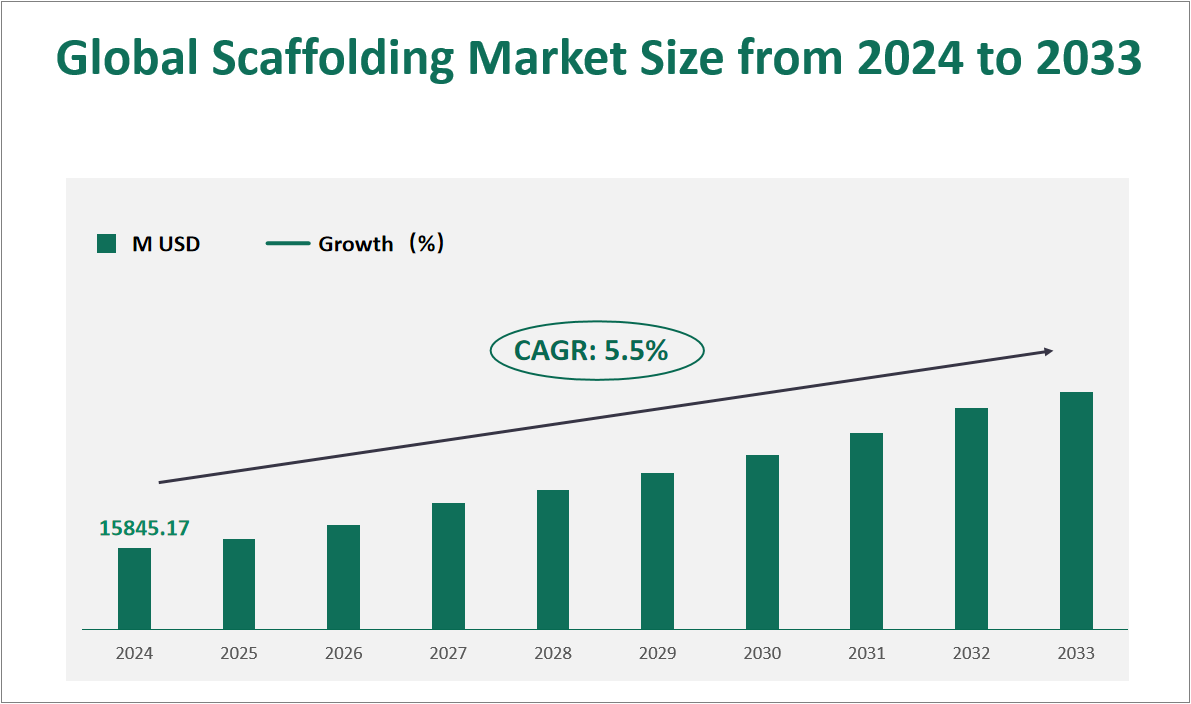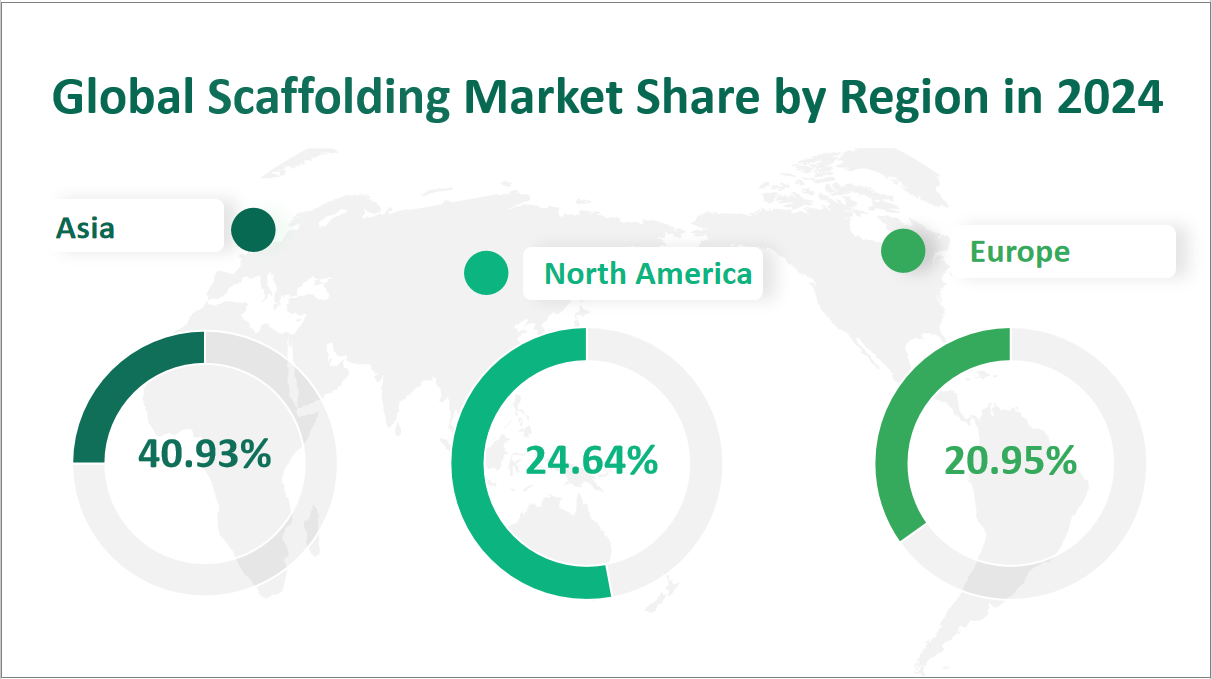1 Global Scaffolding Market Outlook
The global Scaffolding market is projected to exhibit substantial growth in the coming years, with a CAGR of 5.5% from 2024 to 2033, reaching a total market size of $15845.17 million USD in 2024. Scaffolding is a temporary structure used to support workers and materials during the construction, maintenance, and repair of buildings, bridges, and other man-made structures. It is an essential component in the construction industry, providing safe access to heights and areas that would otherwise be difficult to reach. Scaffolding systems come in various types, including frame scaffolding, system scaffolding, and conventional scaffolding, each designed to meet specific construction needs. Frame scaffolding is versatile and widely used for small to medium-sized projects, while system scaffolding offers greater load capacity and flexibility for larger-scale construction jobs. Conventional scaffolding, on the other hand, involves the use of boards and galvanized tubes and is often labor-intensive but suitable for specific applications.
Figure Global Scaffolding Market Size and Growth Rate (2024-2033)

2 Scaffolding Market Growth Drivers and Constraints
The growth of the global scaffolding market is influenced by several driving factors. The primary driver is the increasing investment in the construction industry, particularly in emerging economies. As urbanization accelerates and the demand for new infrastructure grows, the need for scaffolding systems also rises. Additionally, the renovation and maintenance of existing buildings contribute significantly to market demand. The construction industry’s expansion in regions like Asia, South America, and the Middle East is particularly noteworthy, with countries such as China, India, and the United Arab Emirates leading the way. Another driving factor is the increasing awareness of workplace safety, which mandates the use of reliable and safe scaffolding systems to protect workers.
However, the scaffolding market also faces several limiting factors. One of the main challenges is the fluctuating prices of raw materials, such as steel and aluminum, which can impact production costs and profitability. Additionally, stringent safety regulations and standards require manufacturers to invest in high-quality materials and advanced technologies, increasing production costs. The COVID-19 pandemic has also had a significant impact on the market, disrupting supply chains and causing delays in construction projects. In some regions, economic instability and fluctuating demand can also hinder market growth. Despite these challenges, the overall outlook for the scaffolding market remains positive, with growth expected to continue as the global economy recovers and construction activities resume.
3 Scaffolding Market Innovations and M&A Activities
The scaffolding market has seen significant technological innovation in recent years, driven by the need for safer, more efficient, and environmentally friendly solutions. One notable trend is the increasing adoption of modular scaffolding systems, which offer greater flexibility, ease of assembly, and disassembly. These systems are designed to be adaptable to various construction needs, reducing the time and labor required for setup and teardown. Additionally, advancements in materials science have led to the development of lighter, stronger, and more durable scaffolding components, enhancing overall safety and performance.
Corporate mergers and acquisitions have also played a crucial role in shaping the scaffolding market. Major players such as PERI, BrandSafway, and Layher have expanded their market presence through strategic acquisitions and partnerships. For example, in 2021, the Altrad Group acquired RMD Kwikform, a leading provider of formwork and scaffolding solutions, significantly expanding its global footprint. These mergers and acquisitions not only enhance the market reach of companies but also facilitate the integration of new technologies and product lines, driving innovation and competitiveness in the industry.
In conclusion, the global scaffolding market is poised for steady growth, driven by increasing construction activities and urbanization. While challenges such as raw material prices and regulatory requirements persist, technological advancements and strategic corporate moves are set to shape the future of the industry, ensuring continued development and expansion.
4 Global Scaffolding Market Analysis by Type
In 2024, the global scaffolding market is forecasted to reach a total revenue of $15.845 million. The market is segmented by type into three main categories: Frame Scaffolding, System Scaffolding, and Conventional Scaffolding.
Frame Scaffolding is expected to generate a revenue of $7.274 million, accounting for 45.90% of the total market share. This type is popular due to its versatility and ease of use, making it suitable for a wide range of construction projects.
System Scaffolding is projected to achieve a revenue of $5.942 million, holding a market share of 37.50%. System scaffolding is favored for its higher load capacity and flexibility, particularly for large-scale and complex construction projects.
Conventional Scaffolding is estimated to contribute a revenue of $2.629 million, representing 16.60% of the market. This type is more traditional and labor-intensive but remains essential for specific applications where modular systems are not suitable.
These figures reflect the ongoing demand for scaffolding solutions in the construction industry, driven by increasing urbanization and infrastructure development. The market is expected to continue growing as construction activities expand globally.
Table Global Scaffolding Market Size and Share by Type in 2024
Type | Market Size in 2024 (M USD) | Market Share in 2024 (%) |
|---|---|---|
Frame Scaffolding | 7273.65 | 45.90% |
System Scaffolding | 5941.59 | 37.50% |
Conventional scaffolding | 2629.93 | 16.60% |
5 Global Scaffolding Market Analysis by Application
In 2024, the global scaffolding market is forecasted to have a total revenue of $15.845 million, with the following breakdown by application:
Construction Industry: This segment is expected to generate a revenue of $8.593 million, holding a market share of 54.23%. The construction industry remains the largest end-user of scaffolding, driven by increasing urbanization and infrastructure development globally.
Building Maintenance: The revenue from building maintenance is projected to be $1.736 million, accounting for 10.96% of the market. This segment includes activities such as cleaning, painting, repairs, and electrical installations, which require scaffolding for safe and efficient execution.
Industrial Services: This application is expected to contribute a revenue of $4.555 million, representing 28.74% of the market. Industrial services, including oil & gas, shipbuilding, and energy sectors, are significant drivers for scaffolding demand due to the need for temporary support structures and maintenance platforms.
Others: Miscellaneous applications, such as event staging and temporary structures, are estimated to generate a revenue of $961.45 million, holding a market share of 6.07%.
These forecasts reflect the ongoing demand for scaffolding solutions across various industries, driven by construction activities and the need for safe and efficient access solutions.
Table Global Scaffolding Market Size and Share by Application in 2024
Application | Market Size in 2024 (M USD) | Market Share in 2024 (%) |
|---|---|---|
Construction Industry | 8593.27 | 54.23% |
Building Maintenance | 1735.88 | 10.96% |
Industrial Services | 4554.58 | 28.74% |
Others | 961.45 | 6.07% |
6 Global Scaffolding Market Analysis by Region
In 2024, the global scaffolding market is forecasted to reach a revenue of $15.845 million, with the following regional breakdown:
– North America: Revenue is projected at $3.904 million, holding a market share of 24.64%. The region’s market is driven by strong construction activity and infrastructure development in the United States and Canada.
Europe: Revenue is expected to be $3.319 million, representing 20.95% of the global market. Europe’s market is influenced by construction projects and renovation activities across key countries like Germany, the UK, and France.
Asia: This region is the largest market, with a revenue of $6.485 million and a market share of 40.93%. Asia’s market growth is primarily driven by rapid urbanization and infrastructure development in countries such as China, India, and Japan.
South America: Revenue is forecasted at $886.17 million, accounting for 5.59% of the global market. The region’s growth is supported by construction activities in Brazil and other major economies.
Middle East: Revenue is expected to be $404.63 million, representing 2.55% of the global market. The Middle East’s market is driven by large-scale construction projects in countries like the UAE and Saudi Arabia.
Africa: Revenue is projected at $376.00 million, holding a market share of 2.37%. Africa’s market is influenced by infrastructure development and construction activities in key economies like South Africa and Nigeria.
Oceania: Revenue is estimated at $469.60 million, representing 2.96% of the global market. The region’s market is primarily driven by construction activities in Australia and New Zealand.
These forecasts highlight the dynamic nature of the global scaffolding market, with significant growth potential in emerging economies and continued demand in developed regions.
Figure Global Scaffolding Market Share by Region in 2024

7 Top 3 Companies of Global Scaffolding Market
7.1 PERI
Company Introduction and Business Overview:
PERI is a leading global manufacturer and supplier of formwork and scaffolding systems. Founded in 1969 and headquartered in Weisenhorn, Germany, PERI has a strong presence in Europe, Asia, and North America. The company is renowned for its innovative solutions and high-quality products, which are used in a wide range of construction projects, from residential buildings to large-scale infrastructure developments. PERI’s business strategy focuses on continuous innovation, digital transformation, and customer satisfaction.
Products Offered:
PERI offers a comprehensive range of scaffolding products, including:
PERI UP Simple Facade Scaffold: A versatile system with integrated explosion-proof protection.
PERI UP Flex Modular Facade Scaffold: Suitable for high-load applications with adjustable floor grids.
PERI UP Flexible Woven Scaffold: Designed for stability and ease of assembly.
PERI UP Flex Suspension Scaffold: Provides a safe working platform for temporary use.
Sales Revenue in the Latest Year:
PERI’s revenue in the scaffolding segment is estimated to be around $577.36 million, reflecting its strong market position and continuous growth.
7.2 BrandSafway
Company Introduction and Business Overview:
BrandSafway is a global leader in providing access, specialized services, and forming and shoring solutions to the industrial, commercial, and infrastructure markets. The company was formed through the merger of Brand Energy & Infrastructure Services and Safway Group in 2017. Headquartered in the United States, BrandSafway operates in over 50 countries, offering a wide range of products and services. The company’s focus on safety and innovation has made it a preferred choice for many construction projects worldwide.
Products Offered:
BrandSafway’s product portfolio includes:
Systems™ Scaffold: A versatile system with multiple connection points and seismic qualification.
QES® Quick Erect Scaffold: Easy to assemble with minimal loose parts.
CupLok® Scaffold: High-load capacity with heavy-duty work platforms.
Tube & Clamp Scaffold: Compatible with various types of tubing and clamps.
Sales Revenue in the Latest Year:
BrandSafway’s scaffolding revenue is projected to be around $427.12 million, driven by its extensive product range and strong market presence.
7.3 Layher
Company Introduction and Business Overview:
Layher is a leading producer of high-quality, integrated, and modular scaffolding systems. Founded in 1945 and headquartered in Germany, Layher has a global presence with operations in Europe, Asia, and North America. The company is known for its innovative products and commitment to safety and efficiency. Layher’s business strategy emphasizes continuous development and customer satisfaction.
Products Offered:
Layher offers a wide range of scaffolding products, including:
Allround Scaffolding: A lightweight, versatile system suitable for various construction needs.
SpeedyScaf Frame Scaffold: A modular system designed for quick assembly and dismantling.
Roof, Hoarding, and Protection Systems: Solutions for temporary protection and safety during construction.
Sales Revenue in the Latest Year:
Layher’s revenue in the scaffolding segment for 2024 is estimated to be around $788.72 million, reflecting its strong market position and continuous innovation.

